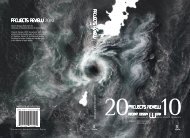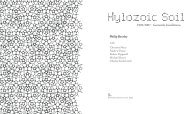The Inner Studio - Riverside Architectural Press
The Inner Studio - Riverside Architectural Press
The Inner Studio - Riverside Architectural Press
Create successful ePaper yourself
Turn your PDF publications into a flip-book with our unique Google optimized e-Paper software.
INTRODUCTION<br />
the library, and as I looked out a different window and studied<br />
from a new chair, it seemed to me that the very shape of the interior<br />
had somehow changed since my first visit to the building a<br />
year earlier. For an entire week I ate my lunch in the library and<br />
consumed everything I could find about the psyche until, without<br />
realizing it, something inside of me shifted and the mysterious<br />
dynamics of the unconscious took hold of me.<br />
I remember leaving the library as it was closing, late in the afternoon<br />
of Christmas Eve, and walking up St. Martin’s Street towards<br />
Leicester Square. <strong>The</strong> darkening street was filled with Londoners<br />
hurrying home or rushing to do last-minute shopping. Standing on<br />
the edge of Leicester Square, I stopped in the midst of this busy<br />
scene and suddenly felt something inside me open. I had always<br />
thought that London was very reserved and its citizens introverted,<br />
but now every face and every building seemed filled with inner<br />
stories and the world was somehow alive and freely expressing<br />
these hidden messages. Amazed, I felt as though I had slipped into<br />
a place that linked and underpinned the built world and the inner<br />
world. Ever since that moment, I have been trying to understand<br />
the practical lessons this experience has to offer.<br />
Through the years that I worked as an architect, I continued my<br />
search. I spent 10 years exploring Buddhism and finally returned<br />
to school to study psychology and began working as a psychotherapist.<br />
I love architecture, but I carried within me a passion to<br />
understand the unseen side of things. It was that feeling that the<br />
world was made of two strands, the seen and unseen, that drew<br />
me to learn about the psyche and the role of the unconscious. I felt<br />
that architecture as it is generally practiced does not include the<br />
richness and complexity we see when we look at things psychologically,<br />
where mystery, uncertainty, or difficult conditions can<br />
surface and become integrated. With the built world, the provisional<br />
and irrational nature of things is seldom acknowledged. I felt<br />
I needed to enter and explore this aspect of the world. From architecture<br />
I learned how to look at the built world and something of<br />
the forces that shape it. From Buddhism I began to appreciate the<br />
depth of inner world. Finally, with psychology, I began to learn<br />
how our inner world and the built world are related.<br />
5





